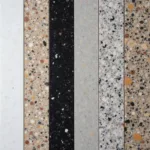Creating the perfect shade of light purple food coloring can seem tricky, but with a few simple techniques, you can achieve the exact pastel hue you desire for your culinary creations. Whether you’re frosting a cake, dyeing Easter eggs, or adding a touch of color to your homemade pasta, understanding how to manipulate colors is essential. This guide will provide you with a comprehensive understanding of how to make light purple food coloring, allowing you to unleash your inner artist in the kitchen.
The key to achieving light purple lies in the careful balance of red and blue food coloring. Start with a small amount of red and gradually add blue until you reach the desired shade. Remember, it’s always easier to add more color than to take it away. how to make light purple with food coloring offers some more helpful tips for beginners.
Mastering the Art of Light Purple Food Coloring
Creating light purple with food coloring involves understanding primary colors and their interactions. While seemingly straightforward, achieving the perfect pastel purple requires precision and a touch of experimentation.
Understanding the Color Wheel
The color wheel is your best friend when working with food coloring. Knowing that purple is a secondary color, created by mixing two primary colors – red and blue – is fundamental. The intensity of each primary color determines the final shade of purple.
- Start with a Base: Begin with a small amount of white frosting, batter, or whatever medium you’re coloring. This provides a neutral backdrop for your colors.
- Add Red: Introduce a tiny drop of red food coloring. Remember, less is more. You can always add more, but it’s difficult to correct an overly saturated color.
- Introduce Blue: Carefully add a drop of blue food coloring, even smaller than the red drop. Observe the color change as the two colors blend.
Adjusting the Shade
Achieving the precise shade of light purple might require some adjustments.
- For a bluer purple: Add another tiny drop of blue.
- For a redder purple (closer to lavender): Add a tiny drop of red.
- For an even lighter purple: Add a small amount of white food coloring or more of your base medium.
what color does pink and blue make when mixed can also give you some insights into color combinations.
Achieving Consistent Results
Consistency is key when working with food coloring. Here are some expert tips for achieving uniform color every time:
- Use Gel Food Coloring: Gel food coloring offers more vibrant and concentrated color compared to liquid varieties. This allows for greater control over the final shade.
- Mix Thoroughly: Ensure the food coloring is fully incorporated into your base medium. Uneven mixing can lead to streaks and blotches.
- Test on a Small Sample: Before coloring your entire batch, test the color on a small portion. This allows you to fine-tune the shade before committing to the full quantity.
“Consistent results in color mixing rely heavily on the quality of your food coloring. Invest in high-quality gel colors for the best results,” advises renowned pastry chef, Amelia Dubois.
Troubleshooting Common Issues
Even with careful attention, you might encounter some color challenges.
Color Too Dark?
If your purple ends up too dark, try adding small amounts of your white base medium to lighten the shade.
Color Too Red or Blue?
If the color leans too much towards red or blue, add a minuscule drop of the opposite color to balance it out.
“Don’t be afraid to experiment! Understanding the interplay of colors is crucial. A little practice goes a long way,” encourages color specialist, Dr. Anya Sharma.
Conclusion
Making light purple food coloring is a delightful process that allows for creativity and experimentation. By understanding the basics of color mixing and following these simple tips, you can achieve the perfect shade of light purple for all your culinary creations. Remember to start with small amounts of color, mix thoroughly, and test before applying to your entire batch. So go ahead, unleash your inner artist and transform your culinary creations with a touch of beautiful light purple! For more information on color combinations, check out what two primary colors make blue.
FAQ
- Can I use liquid food coloring to make light purple?
- What brand of gel food coloring is recommended?
- How can I make a pastel purple color?
- How do I fix a purple that’s too dark?
- Can I mix different brands of food coloring?
- How long does gel food coloring last?
- What other colors can I make using red and blue food coloring?
Do you have any other questions? Check out how to make periwinkle color and what colors do brown and blue make for more color inspiration.
Need help? Contact us at 0373298888, email us at [email protected], or visit us at 86 Cầu Giấy, Hà Nội. We have a 24/7 customer service team.
